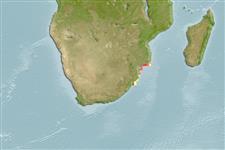Common names from other countries
Elasmobranchii (tubarões e raias) (sharks and rays) >
Rajiformes (Skates and rays) >
Anacanthobatidae (Smooth skates)
Etymology: Anacanthobatis: Greek, ana = up + Greek, akantha = thorn + Greek, batis, -idos = a ray (Ref. 45335).
Environment: milieu / climate zone / depth range / distribution range
Ecologia
marinhas batidemersal; intervalo de profundidade 230 - 322 m (Ref. 5578). Deep-water; 24°S - 30°S, 29°E - 40°E (Ref. 57365)
Western Indian Ocean: known only from southern Mozambique to Durban, South Africa.
Tamanho / Peso / Idade
Maturity: Lm ? range ? - ? cm
Max length : 29.0 cm TL macho/indeterminado; (Ref. 95335)
Descrição suscinta
Chaves de identificação | Morfologia | Morfometria
Espinhos dorsais (total) : 0. A brown-spotted legskate with smooth skin and a short slender tail less than body length; snout angular with tiny filament; pectoral disc with rounded corners; no large thorns on denticles except for alar spines on adult males (Ref. 5578). Legskates have pelvic fins separated into a mobile leg-like front lobe, and a rear lobe that may be fused to the tail base (Ref. 5578). Mottled brown and white with scattered ocelli dorsally; uniform pale ventrally (Ref. 6510). Papillae and rostral filament dark brown (Ref. 6510).
Possibly the smallest southern African skate (Ref. 5578). Found on the upper slope (Ref. 5578).
Ciclo de vida ou comportamento de acasalamento
Maturities | Reprodução | Spawnings | Egg(s) | Fecundities | Larvas
Distinct pairing with embrace (Ref. 205).
McEachran, J.D. and K.A. Dunn, 1998. Phylogenetic analysis of skates, a morphologically conservative clade of elasmobranchs (Chondrichthyes: Rajidae). Copeia 1998(2):271-290. (Ref. 27314)
Status na Lista Vermelha da UICN (Ref. 130435)
CITES (Ref. 128078)
Not Evaluated
Ameaça para os humanos
Harmless
Uso pelos humanos
Ferramentas
Relatórios especiais
Baixar XML
Fontes da internet
Estimates based on models
Índice de diversidade filogenética (Ref.
82804): PD
50 = 0.6250 [Uniqueness, from 0.5 = low to 2.0 = high].
Bayesian length-weight: a=0.01000 (0.00244 - 0.04107), b=3.04 (2.81 - 3.27), in cm Total Length, based on all LWR estimates for this body shape (Ref.
93245).
Nível Trófico (Ref.
69278): 3.6 ±0.6 se; based on size and trophs of closest relatives
Resiliência (Ref.
120179): Baixo, tempo mínimo de duplicação da população 4,5 - 14 anos (Assuming fecundity<100).
Fishing Vulnerability (Ref.
59153): Low vulnerability (19 of 100).
